This was published 1 year ago
Duct tape, two ministers and a tiny ‘bedroom’: The moment that altered Melbourne’s too-small apartments
Too many of Victoria’s apartments are Dickensian: small, dark, poorly insulated and badly built. But we’re going to ask millions more people to live in them. So what can be done to fix this blight?
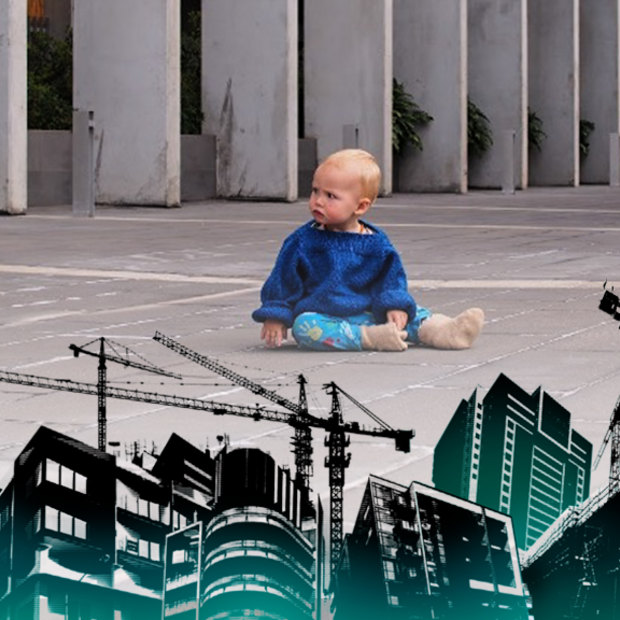
A child in the common play area of a contemporary Melbourne apartment building. Taken by a resident contributing to a paper by Deakin University’s Dr Fiona Andrews.
This article has been republished in light of the state government’s housing announcement. It was originally published on April 29, 2023.
For their first foray onto Melbourne’s property ladder, Natalie and Damien Bean were delighted to find an apartment they could afford on a quiet street, five minutes’ walk from the Queen Victoria Market.
Then they tried to live in it.
One of the world’s great markets was a stone’s throw away but their kitchen was so small they could not store or cook food. Most nights they ordered Uber Eats. When they tried to cook, the steam set off the fire alarm in a common hallway.
“The ventilation was so bad we had to open the balcony door,” Natalie said.
Their West Melbourne apartment was built in 2010, when there were virtually no design standards in Victoria. Two waves of regulation have followed but each, influenced by strong lobbying from the development industry, has left Victoria well behind other states.
Now, as the housing crisis hits hard, the government is once again under pressure to make apartments more livable.
Like too many that were built in that era, Natalie and Damien’s apartment had low ceilings and tiny bedrooms with no window to the outside. The only outside view was from the pint-sized balcony and it was half blocked by a “privacy screen” because the neighbouring apartments were so close. Natalie was paranoid about using the hairdryer because the bathroom transmitted noise between floors.
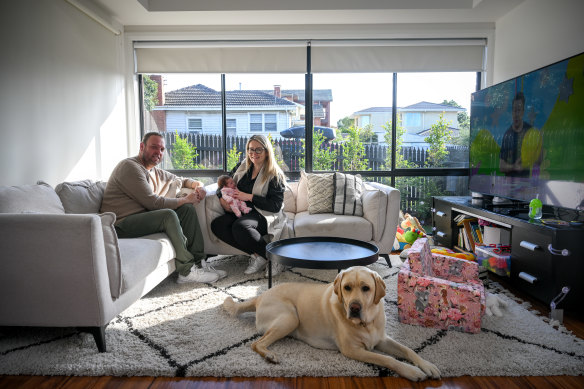
Damien Bean and wife Natalie with daughter Sienna have moved from an inner-city apartment to a town house in Burwood.Credit: Eddie Jim
Then COVID lockdowns hit and Natalie was stuck working from home. The walls felt like they were closing in.
“I couldn’t wait to get out of there,” she said. “We loved the suburb, everything it had to offer – so close to the city, market, North Melbourne. I would definitely live there again. It was literally just the apartment that drove us out.”
Having bought it for $405,000 in 2018 and spent $10,000 to improve it, Natalie and Damien sold their property three years later for $397,000 – an $8000 loss they blame equally on the pandemic and the apartment itself. In the end, they were glad to find a buyer at all.
Their first step on the property ladder had taken them down a rung.
The couple, who have since had a baby, Sienna, now live in a townhouse in Burwood bought with the help of mum and dad. It’s not their ideal location, and they had to buy a second car, but at least it’s livable.
Their story is not unique. Between 2009 and 2020, Melbourne saw an explosion in the number of apartments being built, mainly in the inner city and inner-ring suburbs. In 2016 alone, 19,400 were completed, excluding student accommodation. Many were built cheaply by developers to sell to investors.
Not all were terrible, but tens of thousands were: small, dark, airless, claustrophobic.
Environmentally, socially and economically, Greater Melbourne needs to be more densely occupied. Victoria’s projected population in 2056 will be 11.2 million and Melbourne itself will grow by about 4 million people.
The Victorian government’s planning document, Plan Melbourne, calls for 70 per cent of new housing to be “infill” development in existing suburbs. At the moment, the vast majority of homes are built on the fringe where, according to Infrastructure Victoria, servicing new developments costs four times the price of inner areas.
All this means Victoria needs more apartments, townhouses and units, and people will need to live in them through their life cycles – when they are young, when they have families and in old age.
Research by the Grattan Institute shows that Victorians, particularly younger people, are open to this idea – trading smaller living spaces for proximity to services and a short commute – and already more than 250,000 Victorians live in apartments. But Australia has a strong cultural preference for a house with a yard, particularly when raising children, and in Melbourne, apartments have a deservedly bad reputation.
“A lot of what we hear from community and also some stakeholders is concern about the quality of apartments being built,” said Infrastructure Victoria’s chief executive Jonathan Spear recently, observing “there isn’t strong guidance ... about design quality” in Victorian law.
Urban designers Andy Fergus and Leanne Hodyl said in a recent submission to a parliamentary inquiry that poor quality apartments had a significant impact on people’s health and their quality of life. They agree with other architects, planners and politicians that if they are going to convince more people to live in closer quarters, then designs must improve.
“It is time to refocus our efforts to reflect the function of apartments as homes for people and not investment vehicles.”
What went wrong?
One Monday morning in late winter 2016, the then Victorian planning minister Richard Wynne took a roll of duct tape and a tape measure into a meeting of the state cabinet and marked out a square on the floor.
Outside, the apartment boom was in full swing. Inside, as Premier Daniel Andrews and his cabinet colleagues looked on, Wynne lay down in the square he’d taped out and called for a volunteer to join him. The then attorney-general Martin Pakula obliged.
This square, Wynne told his colleagues, represented the size of the master bedroom in a recently completed Melbourne apartment. It was barely big enough for a queen-sized bed – the occupant was forced to leap in from the hallway just to get to it.
“They asked me if I was kidding,” Wynne said. “The discussion took about 30 seconds after that.” Andrews and his cabinet agreed, for the first time, to impose minimum requirements on apartments – what became known as the Better Apartment Design Standards.
In the 10 years leading up to this decision, perhaps 100,000 apartments had been built in Greater Melbourne. In that time, Victoria had no standard for minimum room sizes, light levels, setbacks from the street or density on a block.
The developers who were driving the boom were interested only in how many apartments they could squeeze in to maximise their yield. Most were sold to investors and the livability problems passed to their tenants.
Building a facade is more expensive than building an internal wall, so units were stacked cheek by jowl, with only one opening to the outside. Those that faced south never saw the sun. Many bedrooms were “snorkels” or “saddlebags”, accessing daylight and ventilation via windows filtering light down internal corridors.
Other bedrooms had “light wells”, which are glorified skylights, or windows looking onto another internal room. In some developments, 30 per cent of the bedrooms were like this, according to Dr Andrew Martel at the Centre for Urban Research at RMIT.
A lack of light is associated with depression and having windows on only one wall also meant no through breeze, so air conditioners or heaters were constantly on.
At the time, Victoria also had no limits on how densely a block could be developed, so buildings were approved in Melbourne that would not have been permitted in New York or Hong Kong – some of the densest cities in the world.
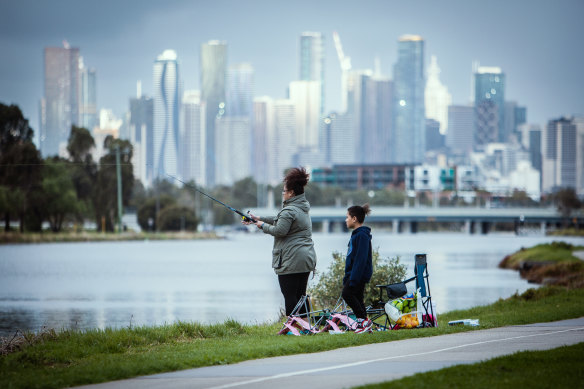
Melbourne’s skyline has been turbocharged with new apartment developments in the past decade.Credit: Scott McNaughton
The lack of rules about open or communal space meant people like Natalie and Damien never met their neighbours, much less developed any fellow feeling with them.
And they were not alone in making a financial loss. A recent CoreLogic report showed 40 per cent of all apartments traded in the City of Melbourne in the last quarter sold for less than their purchase price. The figure was 27 per cent in Stonnington, 22 per cent in the City of Yarra and 20 per cent in Port Melbourne.
Further analysis conducted by CoreLogic at the request of The Age strongly suggests that units built before Wynne taped his square on the cabinet room floor were the ones that had fallen furthest.
So the new design standards fixed it, right?
Under Wynne’s Better Apartment Design Standards, it would be illegal now to build Natalie and Damien’s old apartment.
Coming into force in 2017, the new rules imposed a minimum size for bedrooms (3 metres x 3 metres, and larger for the master bedroom) and a 12-square-metre minimum lounge area.
There was guidance on how deep rooms should be (and therefore how much light filtered to the back of the room); on setbacks from the street and separation from other buildings; the provision of private and communal open space; ventilation; and storage.
In 2021, the standards were updated, mandating more communal space and green space such as courtyards. Developers were required to increase natural light and consider how to avoid wind tunnels at street level. There was a requirement for “deep soil” to encourage canopy trees.
The development industry lobbied to water down the regulations and had some wins.
A proposal in the 2016 draft standards for a minimum ceiling height of 2.7 metres (the rule in NSW) was knocked back to 2.4 metres (the national minimum), reducing the quantity of light that enters the room. The “guidance” about separation from other buildings has been widely ignored, says Fergus.
Of the 2021 update, developer lobby group Urban Development Institute of Australia said in a submission to a recent parliamentary committee inquiry that the amendments would “constrain innovation and encourage homogenous outcomes”. They also worried that the standards would “directly affect the viability of residential development, which in turn will result in fewer jobs, reduced supply of dwellings, and worsening housing affordability”.
The institute’s CEO, Matthew Kandelaars, told The Age that UDIA Victoria “played an active role in the development of the Better Apartment Design Standards and is an advocate for high-quality, sustainable and affordable homes”. However,“regulations and standards don’t necessarily guarantee good design outcomes”.
The Property Council’s submission to the inquiry said any requirement for more communal space should be able to be traded for less “private amenity”, or for “increased height and/or density”, and that apartment design requirements should be “flexible” to keep prices down.
And even now, apartments approved before the standards were introduced are still being built. Construction delays and planning delays sometimes makes the pipeline of building completions years-long. The parliamentary committee concluded it was still too early to judge if the standards had made a difference.
Apartments in Victoria are built under an unusually flexible planning system which imposes few compulsory requirements and enables negotiation over key building attributes such as height, in return for some other proposed gain to the public.
VCAT often has the final say – a process that Fergus says has led to some dreadful outcomes, including often doubling the recommended height limit. In Sydney, developers can negotiate at the margins but only if they offer significant public good such as a community arts space or a public lane or plaza.
Fergus said the government’s Better Apartment Design Standards have merely “lifted Victoria from the 19th to the 20th century”.
But thousands of old, poor-quality apartments still litter Melbourne’s suburbs and Fergus says the quality of the next generation of buildings still falls well short of what’s required. Another round of reform is needed.
Unlike in Victoria ...
Search the words “unlike in Victoria” in the report last year of a parliamentary committee inquiry into apartment design standards and it’s clear the state’s relative lack of rules is unusual.
“Unlike in Victoria, minimum apartment size is mandated in NSW,” the report reveals. “Unlike in Victoria, minimum daylight standards are mandated in NSW.”
NSW’s standard, SEPP 65, also has requirements for building separation and the use of a registered architect on complex projects and large developments. In Victoria, 95 per cent of buildings for housing, including apartments, do not involve an architect.
Unlike in Victoria ...
- Minimum apartment size is mandated in NSW.
- Minimum daylight standards are mandated in NSW and WA.
- WA prohibits the use of lightwells as primary sources of daylight.
- Requirements for building separation are mandated in NSW and WA.
- NSW mandates that apartment designs must be reviewed by experts before they are approved and then verified.
- NSW requires a registered architect to be engaged for complex projects and large developments.
A submission to the inquiry by the Office of the Victorian Government Architect revealed that NSW, WA, Auckland, Dublin, Edinburgh, London and many cities across the US all mandate minimum apartment sizes. The parliamentary committee recommended Victoria adopt such a policy.
In its absence, mandates on the size of bedrooms and living areas under the Better Apartment Design Standards have actually prompted some developers to shrink the size of dining rooms and kitchens to compensate.
“As a consequence of that we end up with apartments that have quite good living – couch – areas but then are missing a dining space or alternatively a kitchen is sort of tucked away in a corridor,” said a submission by the City of Yarra.
The parliamentary committee also called for guaranteed access to quality of air, ventilation and a “clear and quantifiable definition of adequate daylight”.
In NSW, only 10 per cent of apartments can be south-facing – an aspect that denies access to direct sun. There is no such lower limit in Victoria.
The report found there should be more guidance on other qualities that affect people’s lives: the environmental sustainability of apartment design; the amount of noise transferred between apartments; the density of developments; the quality of design and construction; and affordability.
The best buildings, it found, help create a sense of community through communal spaces and random meetings. Residents of these developments refer to them as villages or neighbourhoods.
“It’s quite comforting,” said Manuel Der Hagopian, a Swiss architect who has also worked extensively in Asia, “that you may have someone to help you, or kids’ neighbourhood friends to play with and socialise.”
Another key element is available open space. If your private outdoor space is only a balcony (at best), then you need access to what the parliamentary committee described as “a network of open spaces located closer to their place of residence”, to kick a footy and hang out in nature.
The desire for better lifestyles was turbocharged by COVID-19. Research by Alexa Gower at the Australian Housing and Urban Research Institute showed that, during Melbourne’s long lockdowns, even those who lived densely, but in neighbourhoods with good parks stayed positive for longer than those suffering in “poor amenity” areas.
The government is expected to respond to the parliamentary committee report in coming months.
Planning Minister Sonya Kilkenny said Victorians “should have access to high-quality, comfortable, and sustainable homes near their family and friends in areas where they want to live”.
“We are constantly reviewing planning rules and looking at ways we can improve design standards to maintain Victoria’s liveability,” she said.
In European cities where apartment living is more common, development is primarily low and medium rise. Theories of “human scale” development by thinkers such as Robin Dunbar and Jan Gehl suggest communities form when there are fewer than 40 people in a building, or when you can see your neighbours from the street.
Human scale must be represented inside the building too. In a study of urban livability by Deakin University senior lecturer Fiona Andrews, a fed-up apartment dweller described the corridor off which all the apartments in her building led as “the hallway of death”.
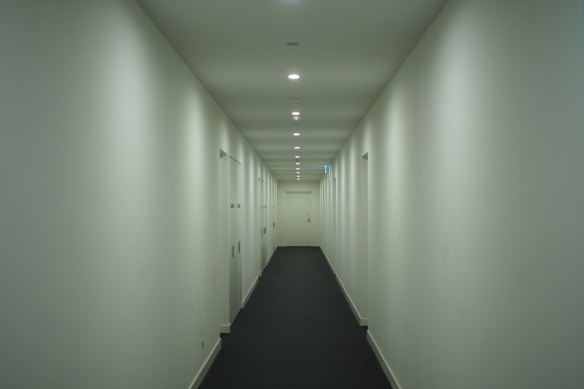
The hallway of death. One woman contributed this photo to an academic study by Dr Fiona Andrews of family living in apartments.
A submission by the Urban Design Forum Australia, a group of designers, architects and planners, said in Victoria it was also “entirely possible to arrange as many as 30 apartments off a single lift lobby and corridor, creating an environment more akin to a hotel corridor than a space to foster meaningful social interaction”.
“These corridors can then be stacked in buildings with as many as 500 apartments ... sharing a single lobby, which takes on the anonymity of an office foyer rather than a domestic front door,” the forum said.
It was critical, the group concluded, that apartment numbers be limited to eight dwellings sharing a lobby at each level of a building, or 12 at a pinch.
Not designed for them
Emma and Josh Finch are renting a lovely apartment in Windsor. It’s spacious, has two bedrooms and a large, north-facing terrace with a safe, high fence. But even so, as daughter Grace gets bigger and more active, they say it’s getting “gradually trickier” to cope.
The terrace is concrete and hard for Grace to play on, there are no other families in their building and no common play area or communal space. When Josh works from home, it’s at a desk in Grace’s bedroom, so when she goes to bed for a nap, he must move to the kitchen table. The car stacker in the basement makes Emma feel uneasy for Grace’s safety.
They want to move. Emma said the ideal place would be a house with a yard. However, in return for a good location they would happily live in another apartment, but only if it had a third bedroom and good storage (“We like to go camping, and you just have heaps of stuff when you have a kid”).
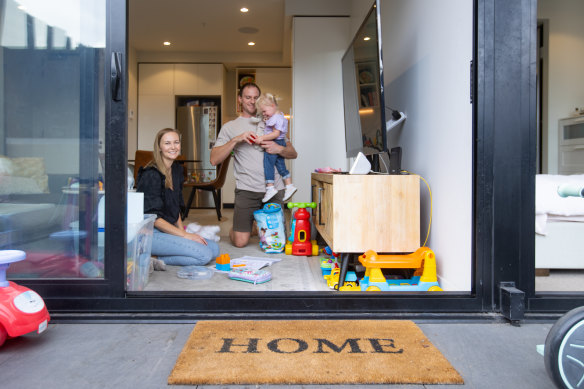
Emma and Josh Finch and daughter Grace, 2, in their Windsor apartment.Credit: Simon Schluter
“We spend a lot of time on Domain looking to see what’s coming up, but the minute you change the search criteria from two bedroom to three bedroom, there are very few,” Emma said. “A lot that exist are the older, two-storey, art deco style units and they typically don’t have any storage – built in ’robes, a cage, a garage.”
In Australia, it’s become traditional to rent an apartment when young and single, or in a couple, then when children are in the offing to buy a house in the suburbs, even if it means a two-hour, soul-destroying commute to work.
But already, according to the last census, 20 per cent of households living in apartments in Australia were families with children – and they are forecast to represent the highest rate of growth in Victorian households from 2016 to 2056. Despite this, only 5 per cent of Melbourne apartments have three or more bedrooms. During COVID, searches on Domain for properties with home offices shot up by 830 per cent.
“The vast majority of families in apartments are living in homes not designed for them,” said Fiona Andrews.
Take the kitchen, for most people the warm heart of the home. The Better Design Standards gave minimal guidance, suggesting only “sufficient space for cooking, cleaning, food preparation and storage”.
This, Andrews said, was leading to small, mean kitchens. Without room to store, prepare and cook food or sit down for a meal, people spend more money on food and their diet suffers, as does the education of children in cooking and eating home-cooked food.
“If a family is going to live in a two-bedroom apartment, then it ought to be set up to accommodate four people. Two parents and two kids.
“It needs to be a home, not just a transit.”
‘North Northcote’
The lack of apartment choice and quality is written on the fabric of the city.
Victoria will require an additional 2.3 million dwellings to house its growing population by 2056 and it’s not sustainable to put them all on the outskirts. But between 2006 and 2016, the population of Melbourne’s CBD increased a little more than Sydney’s while the inner suburbs grew more slowly. Melbourne’s outer suburban fringe, on the other hand, grew at twice the pace of Sydney’s, adding 600,000 extra people – the opposite of what Plan Melbourne is about.
Swiss architect Manuel Der Hagopian, after a recent visit to Melbourne, described it as a “carpet city”. Deputy Lord Mayor of Melbourne Nicholas Reece said Melbourne had made a “Faustian bargain ... where in the central city is almost sky’s the limit, while most of greater Melbourne is locked up from even modest mid-rise”.
People like Zak Hamer and Erin Mould are among the refugees from the city. They would have liked to bring up baby Reuben in an inner suburb. But when their time came to buy something bigger than their poky Thornbury rental apartment, they found it impossible.
“I wanted anywhere I could grow some tomatoes,” Erin said. “I’d have been happy with a courtyard.”
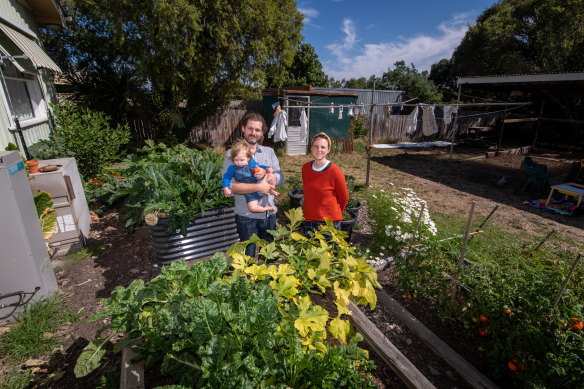
Zak Hamer, wife Erin Mould and son Reuben Hamer, in their garden in Castlemaine.Credit: Justin McManus
The first unit they bid on, in Reservoir, was a “compromise on location, the size of the house and the condition of the house and it still went for an obnoxious amount over our limit,” Zak said. After months of trying, his mum found them a place. In Castlemaine.
He grew up in a small Port Melbourne terrace and said it was “heartbreaking” that such a lifestyle was out of reach of most young families.
“There was a lot of life nearby. In our block there was a pub, a milk bar, a lolly shop, a supermarket … It felt like a real neighbourhood.”
He and Erin are slowly getting used to being two hours from the city and raising young Reuben, 2, as a country boy. And Castlemaine is slowly getting used to being inundated by Melburnians.
“Everyone we know basically is a Melbourne expat. It does seem like there’s two worlds up here – the locals and the imports,” Zak said.
“North Northcote, they call it.”
Getting this right is important. As social researcher Hugh Mackay noted in his Australia Day speech in 2019, planning and building cities where we know our neighbours and care for them is not just about our own health, but is about “the state of the nation”.
“Social interaction builds social cohesion; social cohesion builds social capital. Social capital builds strong societies.”
The Morning Edition newsletter is our guide to the day’s most important and interesting stories, analysis and insights. Sign up here.